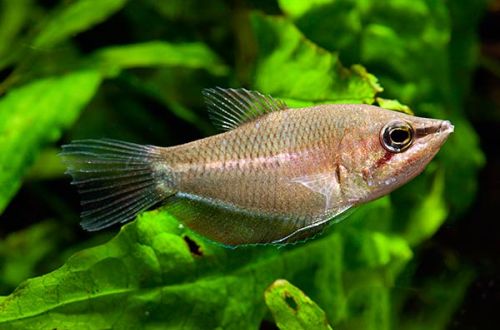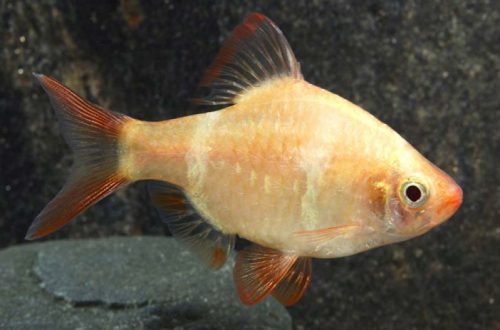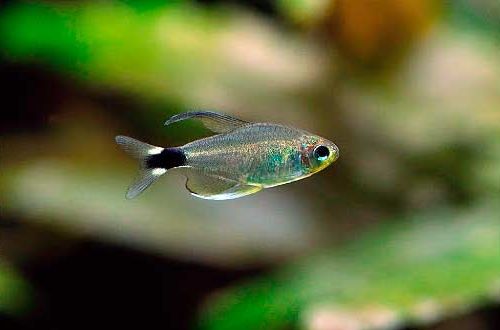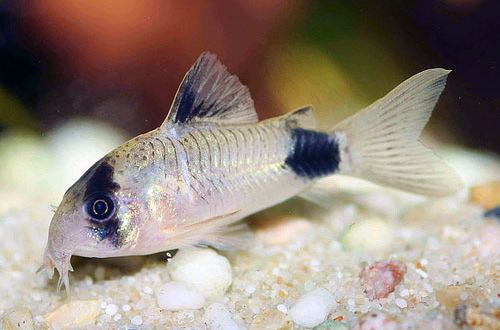
Giant chocolate gourami
The giant chocolate gourami, scientific name Sphaerichthys acrostoma, belongs to the Osphronemidae family. The fish are not brightly colored and require very low pH and dGH values, which can be difficult for beginner aquarists to supply. These factors predetermined the weak distribution of this species in amateur aquarism.

Contents
Habitat
It comes from Southeast Asia from the Indonesian part of the island of Borneo. Inhabits the Mentaya River basin. The natural range is limited to the territory of the province of Central Kalimantan. It is found in peat bogs located among the tropical forest. A typical biotope is a shallow reservoir, the bottom of which is covered with a thick layer of fallen leaves, twigs and other snags. The water has a rich brown hue due to the high concentration of humic acids and other tannins.
Brief information:
- The volume of the aquarium – from 80 liters.
- Temperature – 21-25°C
- Value pH — 3.5–6.5
- Water hardness – 1–3 dGH
- Substrate type – any dark
- Lighting – subdued
- Brackish water – no
- Water movement – little or no
- The size of the fish is 6-7 cm.
- Food – any food
- Temperament – peaceful
- Content – in a group of relatives and together with other species
Description
A relative of the Chocolate Gourami, but outwardly they have little in common. Although the name of the species contains the word “giant”, the size of this fish is rather modest. Adults reach a length of 6-7 cm. Gourami has a high narrow body and a large pointed head with large eyes. The coloration is gray, the fins are translucent with a weakly pronounced ornament. During the mating season, males show a lateral stripe, stretching from the base of the tail to the middle of the body.
Food
Fish grown in the artificial environment of aquariums and supplied for retail sale, as a rule, are accustomed to receiving popular foods in dry, frozen and live form. The latter are the most preferred.
Maintenance and care, arrangement of the aquarium
The optimal size of the aquarium for a small group of fish starts from 80 liters. The design should provide for places for shelters, using natural or artificial decor. A good choice would be snags and thickets of plants. Additionally, you can use the dried leaves of some trees (oak, birch, maple, exotic Indian almonds, etc.). They will give the design more naturalness, as well as bring the chemical composition of the water closer to that in which the fish live in nature, due to the release of the tannins contained in them. Read more in the article “Which tree leaves can be used in an aquarium.”
An important condition for the successful maintenance of the Giant Chocolate Gourami is the quality of the water. Although the inhabitants of wetlands are not as demanding as their relatives from rivers and streams, this species needs to maintain very low hydrochemical values in the acceptable range of pH and dGH. The stability of the biological system of an aquarium depends on the regularity of its maintenance (removal of waste, weekly replacement of part of the water) and the smooth operation of the equipment, primarily the filtration system.
Behavior and Compatibility
Peaceful sluggish fish, does not belong to schooling species, but according to observations, it feels most comfortable in the company of relatives. It is recommended to purchase a group of 3-4 individuals. The choice of neighbors in the aquarium should be taken with great care. It is worth avoiding overly active and even more aggressive fish. Good compatibility is achieved with people from a similar habitat, reaching the same size.
Breeding / breeding
If Gourami are in the right environment and given a balanced diet, then breeding will not be difficult. The signal for the approach of the breeding season is, as noted above, the appearance of the lateral stripe in males. In fish, roles in caring for offspring are unusually distributed. The female initiates courtship and the male takes care of the eggs. The spawning process can take several hours, the male takes all the fertilized eggs into his mouth, where they will stay until the fry appear – about 3 weeks. Juveniles are fully formed and immediately begin to swim in search of food. Parents no longer show interest in offspring.
Fish diseases
The cause of most diseases is unsuitable conditions of detention. A stable habitat will be the key to successful keeping. In the event of symptoms of the disease, first of all, the quality of the water should be checked and, if deviations are found, measures should be taken to correct the situation. If symptoms persist or even worsen, medical treatment will be required. Read more about symptoms and treatments in the Aquarium Fish Diseases section.





